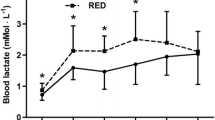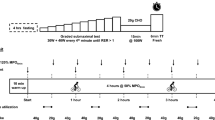Summary
The metabolism of eight men (mean: age, 26.0 years; maximal oxygen consumption, 65.0 ml·kg−1 · min−1; body fat, 10.3%) was measured on counterbalanced control (baseline values for 8h) and experimental (post 35 km run values for 8 h) days. The excess postexercise volume of oxygen consumed of 32.37 1 and increase in energy used of 594 kJ during the 8 h after completion of the run were equivalent to average increases of 23.7 and 21.1%, respectively, when compared with time-matched controls. Furthermore, the oxygen uptake and energy expenditure were still elevated by 12.7 (P<0.0005) and 9.7% (P=0.001), respectively, at the mod, of this period but the fact that they had returned seline 24 h after the 35 km road run contrasts with some reports in the literature that metabolism is still elevated at this time following less demanding exercise intensities. Rectal temperature was elevated by 2.3° C at the end of the run but the difference had decreased to 0.2°C by 7 h postexercise. The respiratory exchange ratio and changes in blood metabolites (nonesterified fatty acids, glycerol and ketone bodies) indicated a greater postexercise utilisation of fat notwithstanding a 6300 kJ meal ingested on both control and experimental days. The highest measured serum creatine kinase enzyme activity of 1151 U.l−1 (P< 0.05) occurred 24 h postexercise, as compared with the control value of 145 U · 1−1, and indicates the possibility of skeletal muscle damage.
Similar content being viewed by others
References
Bahr R, Maehlum S (1986) Excess post-exercise oxygen consumption — a short review. Acta Physiol Scand 128 [Suppl 556]:99–104
Bahr R, Ingnes I, Vaage O, Sejersted OM, Newsholme EA (1987) Effect of duration of exercise on excess post exercise O2 consumption. J Appl Physiol 62:485–490
Benedict FG, Carpenter TM (1910) The metabolism and energy transformations of healthy man during rest. Carnegie Institution of Washington, Washington DC, pp 182–193
Bergmeyer HU (1974) Methods of enzymatic analysis. Academic Press, London
Berry MN, Clark DG, Grivell AR, Wallace PG (1983) The calorigenic nature of hepatic ketogenesis: an explanation for the stimulation of respiration induced by fatty acid substrates. Eur J Biochem 131:205–214
Bielinski R, Schutz Y, Jéquier E (1985) Energy metabolism during the post-exercise recovery in man. Am J Clin Nutr 42:69–82
Brehm BA, Gutin B (1986) Recovery energy expenditure for steady state exercise in runners and nonexercisers. Med Sci Sports Exerc 18:205–210
Bunt JC (1986) Hormonal alterations due to exercise. Sports Med 3:331–343
Burton AC (1935) Human calorimetry II — the average temperature of the tissues of the body. J Nutr 9:261–280
Chad KE, Wenger HA (1985) The effects of duration and intensity on the exercise and post-exercise metabolic rate. Aust J Sci Med Sport 17(4):14–18
Clark RP, Edholm OG (1985) Man and his thermal environment. Arnold, London p 13
Courtice FC, Douglas CG (1936) The effects of prolonged muscular exercise on the metabolism. Proc R Soc Lond (Biol) 119:381–439
Davidson L, Vandongen R, Bellin LJ (1981) Effect of eating bananas on plasma free and sulfate-conjugated catecholamines. Life Sci 29:1773–1778
Duran WN, Renkin EM (1976) Influence of sympathetic nerves on oxygen uptake of resting mammalian skeletal muscle. J Appl Physiol 231:529–537
Edwards HT, Thorndike A Jr, Dill DB (1935) The energy requirement in strenuous muscular exercise. N Engl J Med 213:532–535
Flatt JP (1978) The biochemistry of energy expenditure. In: Bray G (ed) Recent advances in obesity research. Newman, London pp 211–228
Freedman-Akabas S, Colt E, Kissileff HR, Pi-Sunyer FX (1985) Lack of sustained increase inVO2 following exercise in fit and unfit subjects. Am J Clin Nutr 41:545–549
Fridén J, Sjöström M, Ekblom B (1983) Myofibrillar damage following intense eccentric exercise in man. Int J Sports Med 4:170–176
Gaesser GA, Brooks GA (1984) Metabolic bases of post-exercise oxygen consumption: a review. Med Sci Sports Exerc 16:29–43
Gladden LB, Stainsby WN, MacIntosh BR (1982) Norepinephrine increases canine skeletal muscle\(\dot VO_2 \) during recovery. Med Sci Sports Exerc 14:471–476
Gore CJ, Withers RT (1990) The effect of exercise intensity and duration on the post-exercise metabolism. J Appl Physiol 68:2362–2368
Gore CJ, Withers RT, Woods GF, Day L (1987) Inexpensive probes for the determination of body temperature. Br J Sports Med 21:127–129
Grande F (1980) Energy expenditure of organs and tissues. In: Kinney JM, Lense E (eds) Assessment of energy metabolism in health and disease. Ross Laboratories, Columbus, Ohio, pp 88–92
Hermansen L, Grandmontagne M, Maehlum S, Ingnes I (1984) Post exercise elevation of resting oxygen uptake: possible mechanisms and physiological significance. In: Marconnet P, Poortmans J, Hermansen L (eds) Physiological chemistry of training and detraining. Karger, Basle, p 119–129
Herxheimer H, Wissing E, Wolff E (1926) Spätwirkungen erschöpfender Muskelarbeit auf den Sauerstoffverbrauch. Z Exp Med 51:916–928
Hill AV, Lupton H (1923) Muscular exercise, lactic acid and the supply and utilisation of oxygen. Q J Med 16:135–171
Kapoor V, Chalmers JP (1987) A simple sensitive method for the determination of extracellular catecholamines in the rat hypothalamus using in vivo dialysis. J Neurosci Methods 19:173–182
Lusk G (1976) The elements of the science of nutrition. Johnson Reprint Corporation, New York, p 65
Maehlum S, Felig P, Wahren J (1978) Splanchnic glucose and muscle glycogen metabolism after glucose feeding during post-exercise recovery. Am J Physiol 235:E255–260
Maehlum S, Grandmontagne M, Newsholme EA, Sejersted OM (1986) Magnitude and duration of excess post exercise oxygen consumption in healthy young subjects. Metabolism 35:425–429
Molé PA (1990) Impact of energy intake and exercise on resting metabolic rate. Sports Med 10:72–87
Newsholme EA (1978) Substrate cycles: their metabolic, energetic and thermic consequences in man. Biochem Soc Symp 43:183–205
Nicholls DG, Locke RM (1984) Thermogenic mechanisms in brown fat. Physiol Rev 64:1–64
Noakes TD (1987) Effect of exercise on serum enzyme activities in humans. Sports Med 4:245–267
Passmore R, Johnson RE (1960) Some metabolic changes following prolonged moderate exercise. Metabolism 9:452–456
Piehl K (1974) Time course for refilling of glycogen stores in human muscle fibres following exercise-induced glycogen depletion. Acta Physiol Scand 90:297–302
Ramanathan NL (1964) A new weighting system for mean surface temperature of the human body. J Appl Physiol 19:531–533
Roussos C, Campbell EJM (1986) Respiratory muscle energetics. In: Fishman AP, Macklem PT, Mead J, Geiger SR (eds): Handbook of physiology, section 3. The respiratory system, vol 3. American Physiological Society, Bethesda, Maryland, pp 481–509
Sainsbury DA, Gore CJ, Withers RT, Ilsley AH (1988) An on-line microcomputer program for the monitoring of physiological variables during rest and exercise. Comput Biol Med 18:1724
Saltin B, Hermansen L (1966) Esophageal, rectal and muscle temperature during exercise. J Appl Physiol 21:1757–1762
Siri WE (1961) Body composition from fluid spaces and density: analysis of methods. In: Brožek J, Henschel A (eds): Techniques for measuring body composition. National Academy of Sciences National Research Council, Washington, DC, pp 223–244
Viru A (1987) Mobilisation of structural proteins during exercise. Sports Med 4:95–128
Withers RT, Craig NP, Bourdon PC, Norton KI (1987) Relative body fat and anthropometric prediction of body density of male athletes. Eur J Appl Physiol 56:191–200
Author information
Authors and Affiliations
Rights and permissions
About this article
Cite this article
Withers, R.T., Gore, C.J., Mackay, M.H. et al. Some aspects of metabolism following a 35 km road run. Europ. J. Appl. Physiol. 63, 436–443 (1991). https://doi.org/10.1007/BF00868075
Accepted:
Issue Date:
DOI: https://doi.org/10.1007/BF00868075




